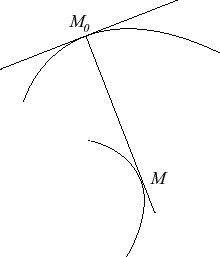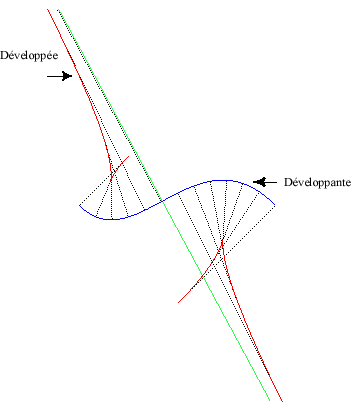
Cartesian parametrization:
Complex parametrization:
If the initial curve's intrinsic equation 2 is
Parametric intrinsic equation 1:
Intrinsic equation 2:
| next curve | previous curve | 2D curves | 3D curves | surfaces | fractals | polyhedra |
EVOLUTE OF A PLANE CURVE
| Notion studied by Apollonius, around 200 BC then by Huygens
in 1673.
Other names: focal curve, or caustic. |
The evolute of a curve is the locus of its centres
of curvature, or also the envelope of its normals.
 |
For an initial curve Cartesian parametrization: Complex parametrization: If the initial curve's intrinsic equation 2 is Parametric intrinsic equation 1: Intrinsic equation 2: |
Kinematic interpretation: the evolute is the base
of the movement of a plane over a fixed plane, when the moving plane
is linked to the tangent to the curve. The rolling curve is its normal,
and therefore rolls without slipping on the evolute.
 |
The singularities of the evolute correspond to the vertices
of the curve, i.e. to the extrema of the radius of curvature, notion that
generalises that of a point located on a symmetry axis perpendicular to
the tangent at this point.
Opposite, note that the radius of curvature has two nonzero minima and an infinite maximum. In the latter case, the singularity is at infinity, and the normal is the asymptote to the evolute. |
The evolutes of two similar curves are similar (with the same similarity); the evolute of an algebraic curve is an algebraic curve.
Physical interpretation: considering the curve
as a light source, the evolute represents the locus where the rays emitted
by this curve are concentrated. The evolute is therefore rather called
caustic
in optics (but see the similar definition of the caustic
in math); it is also the locus of the singularities of wavefronts emitted
by
(see
at parallel curves).
The evolute of the orthotomic
curve of
with respect to a point S (itself image of the pedal
of
with
respect to S by an homothety with centre S and ratio 2),
is the caustic by reflection with
centre S of
,
and to put it in a nutshell:
Evolute of pedal = caustic
Therefore, the evolutes of limaçons
of Pascal and the caustics of circles are the same curves.
Examples:
| initial curve | evolute |
| ellipse |
tetracuspid with |
| hyperbola |
1/2
Lamé curve: |
| parabola |
semicubical
parabola |
| cycloid | same cycloid, translated |
| cardioid | similar cardioid with ratio 1/3 |
| nephroid | similar nephroid with ratio 1/2 |
| epicycloid with parameter q | similar epicycloid with ratio q/(q+2) |
| deltoid | similar deltoid with ratio 3 |
| astroid | similar astroid with ratio 2 |
| hypocycloid with parameter q | similar hypocycloid with ratio q/(q-2) |
| paracycloid | hypercycloid |
| hypercycloid | paracycloid |
| logarithmic
spiral |
logarithmic spiral |
| tractrix | catenary |
| tractrix spiral | Catalan curve |
| catenary | curve |
| Cayley sextic | nephroid |
| Norwich spiral | involute of a circle |
See also at involute,
see a planar generalisation at evolutoid,
see the notion of evolute
of a 3D curve, the notion of pedal
surface and the notion of focal,
which is to surfaces what the evolute is to curves.
| next curve | previous curve | 2D curves | 3D curves | surfaces | fractals | polyhedra |
© Robert FERRÉOL 2017